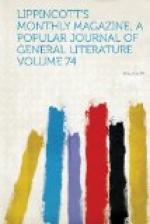Before this is done, however, the seed-corn has begun to sprout in the ground. The first cry of the whippoorwill is the signal for planting this cereal. The grains are dropped from the hand at regular intervals, both men and women joining in this work; and they all move slowly along together, the men bearing the corn in small bags, the women holding it in their aprons. The wide low-grounds at this season expand to the horizon without anything to obstruct the vision, a clear, unbroken sweep of purple ploughed land. The laborers are visible far off, those who drop the grains walking in a line ahead, the hoers following close behind to cover up the seed. Still farther in the rear come the harrows, that level all inequalities in the surface and crush the clods. Flocks of crows wheel in the air above the scene, or stalk at a safe distance on the ploughed ground. Blackbirds, which have now returned from the South, sing in chorus on the adjacent ditch-banks, mingling their harsh notes with the lively songs of myriads of bobolinks, while high overhead whistles the plover. The newly-sprung grass paints the road-side a lush green, the leaves are budding on weed and spray, and over all there hang the exhilarating influences of spring.
As soon as the hands have planted the corn, they begin transplanting the tobacco, which they find a more tedious task, for they can only transfer the slips to the fields when the air is surcharged with moisture and the ground is wet; otherwise the slips will wither on the way or perish in the hill without taking root. But if the weather is favorable they flourish from the hour they are thrust into the ground. It takes the laborers but a short time to plant many acres; and when their work is done the fields look as bare as before. The original leaves soon die, but from the healthy stalk new ones shoot out and expand very rapidly. The soil has been very highly fertilized with guano and very carefully ploughed, so that every condition is favorable to the growth of the plant if there is an abundance of rain. At a later period it passes through a drought very well, being a hardy plant that recovers even after it has wilted; but very frequently in its early stages the laborers are compelled to haul water in casks from the streams to save it from destruction.




